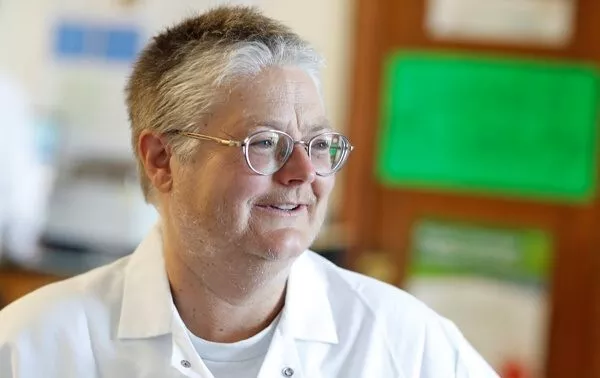Ticks are ‘coming back with a vengeance’ in Nova Scotia | Environment | Halifax, Nova Scotia
Changing leaves and a crispness in the air are just around the corner. But the arrival of fall brings more than the return of pumpkin spice and apple picking. After a break during the warmer months, ticks are back on the scene.
We’ll start seeing a lot more ticks once the weather starts to cool in September, and they’ll be around until November, says Vett Lloyd, researcher and director of the Lloyd Tick Lab at Mount Allison University in Sackville, NB. The difference between tick seasons is that in the spring, it’s the hungry, overwintering adults that are out and about, and they’re bigger and easier to see, Lloyd explains. “In the fall, we have some adults that have managed to reach the adult stage and they would like a good blood meal to get them through the winter. Plus, we have the juvenile immature stages, which are just as hungry, but the bad news here is that they’re smaller and harder to see,” she says. “There are ticks outside, basically. There is no difference.”
“Anywhere in Nova Scotia is bad for ticks”
Nova Scotia has the second highest number of ticks in Canada (after Ontario), and the highest tick-to-human ratio. Ticks love the warm, humid climate of our province, and there are many of their favorite foods here: mice, deer and coyotes. The province is home to several types of ticks, but the black-legged tick, also known as the deer tick, is the one that carries the bacteria that causes Lyme disease. Black-leggeds first appeared along the South Coast and have spread across the province over the years. “So pretty much everywhere in Nova Scotia is bad for ticks and bad for Lyme disease,” says Lloyd. The epicenter of ticks carrying Lyme disease is in the South Shore and New Glasgow areas, where about 40% of blacklegged ticks carry the bacteria, she says. The rate is lower in other regions, but “what matters to people is that you have a tick on your leg, you don’t care what the provincial average is.”
And the tick population is on the rise, says Lloyd. A big factor is climate change. “Every time a female can get a good full blood meal, she can lay about 3,000 eggs,” she explains, “so that means the population can grow and grow very quickly. In In the past, the cold winters have killed many of the young ticks because they are a little delicate, but the winters are not as cold, the snow is not as deep, and so more of those babies are surviving to get their meal. of blood and to make their ticks 3,000 odd”. There are other reasons as well, such as changes in our eating habits. We eat far less deer than we did 100 years ago, so now there are far more deer to deal with can feed on ticks, says Lloyd.
Of course, more ticks mean more Lyme disease ticks. The parasites aren’t born with the bacteria, they get it from animals like wild mice, which are their main food source, Lloyd says. “If that mouse is infected, ticks become infected and then they can pass it on to the next host—so as things go on, infected ticks will infect more mice, those more mice will infect more ticks, so snowballs fall. And that’s what’s happening.”
How to protect yourself
If you plan to do a lot of hiking in the fall, the number one precaution you should take is routine tick checks, says Lloyd. At the end of the day, just like brushing your teeth, you have to stand in front of a mirror “and you’re very carefully checking your whole body for things that look like moles but have attached legs. The moment you see the legs, it’s no longer a mole,” she says.
“Don’t expect them to be flashing lights and big big things. Check every nook and cranny,” Lloyd says. In children, ticks are usually found around the hairline, while in adults, they tend to be lower on the body. “They hang out in warm, dark places. So that means that adults will have to start looking at parts you wouldn’t normally look at, but that’s the way it goes,” she says. There are several tick repellants available on the market, and mosquito repellants are “somewhat effective.” You can also cover your body when you’re outside, for example by tucking your pants into your socks. One precaution people absolutely shouldn’t take, Lloyd says, is staying indoors. “We live in a beautiful part of the world. So absolutely, people should go for a walk.”
If you find a tick, remove it from you. “There’s a bit of mystique to what to do and what not to remove a tick, but perhaps the most important thing to remember is to remove it. Don’t spend too much time googling how to do it. If I take it out of myself, fine.” (To save you from Googling, use tweezers and slowly and carefully pull away as close to the skin as possible. Do not squeeze or twist the tick.) It is important to catch the tick early, within 24 hours of the bite, when you take risks. the infestation will be the lowest. If the ticks have been feeding for longer, or you get tested and know it’s infected, Lloyd recommends seeing a doctor to get a two-week course of antibiotics: “That will be preventative, as long as that you are catching it early. ” You can send your tick for Lyme disease testing, but it is a private service. “People have to pay for what is bad. Well, it’s stuffy, but no pun intended,” says Lloyd.
Monitor your symptoms after a tick bite and watch for fever, headache, fatigue, joint pain, or rash. Lloyd says not everyone will have a rash when Lyme disease starts and you may think you have a cold or COVID. So it is important to pay attention. “Once Lyme disease is present in your body, the bacteria that will spread around your body will settle in different organs and that’s when the real damage starts. So one wants to avoid it. So preventatives like bug spray, like religious tick control. Paying attention to fever because fever means something is wrong,” says Lloyd.
What’s happening in tick research?
Lloyd says that given the number of people who are affected by Lyme disease, it is vastly under-researched and under-funded. “I think that’s a historical mistake, because traditionally it’s been treated as a mild illness, taking antibiotics for a day or two, or maybe a week, and you’ll be fine. And what we’re realizing now is that it’s a very serious disease — once it gets into your major organs, it’s debilitating,” she says.
Like many other tick researchers, Lloyd began working with them after having a tick-borne illness. She was bitten while gardening 10 years ago. “Ricks weren’t officially present in New Brunswick at the time, but I live on the border with Nova Scotia. And so this was just a political issue. The Tiks were not aware that there was a provincial border there and that they had to stop at the border,” she says. Lloyd converted her lab, which used to study cancer, into one that studies far less researched tick-borne diseases. “The state of knowledge didn’t stop me from getting sick and it didn’t help me get better until I kept fighting for it,” Lloyd says. “And I wanted to do what I could to help. That was a decade ago, and I’m still trying.”
lloydticklab.ca
Vett Lloyd captured the bug for the study of tick-borne diseases after catching a bug from a tick.
Lloyd is currently researching variants of Lyme disease and other pathogens, such as anaplasmosis, that can be found in ticks. “Nova Scotia is at the forefront of emerging new pathogens that we’re finding in ticks. So congratulations to Nova Scotia for being on the cutting edge of new pathogens in ticks,” she says. “And hopefully health care providers will be kind of aware that they don’t just have to worry about Lyme disease when someone comes in with a tick bite.”
Medically, the current diagnostic regimen has barely changed since the ’80s and ’90s, so Lloyd hopes it will improve once people realize how serious Lyme disease is. “We can do better than that. And it’s time to do that,” she says. Her lab used to test ticks for free, but funding for that ran out. With more testing and a more accurate diagnostic regimen, she wants to see health care more specific to people’s needs.
Across the border, an exciting development in tick research is taking place in the form of a Lyme disease vaccine for wild mice. “If they’re not able to carry the Lyme disease bacteria, we still have ticks, but they’re not transmitting disease. This is a step up,” says Lloyd.
Lloyd says Nova Scotians are generally well informed about ticks, but our health care system can be a stumbling block when it comes to proper treatment. “The health care system is in trouble. So if they’re struggling to deal with heart attacks and people with chainsaw injuries, a tick bite might not seem that serious, but it still needs to be treated.”
More bookmark resources
- eTick is a free online tool that can identify ticks and includes an interactive map of tick sightings.
- Government of Nova Scotia bookmark the security page
- Nova Scotia Health Authority Lyme Disease Pamphlet





